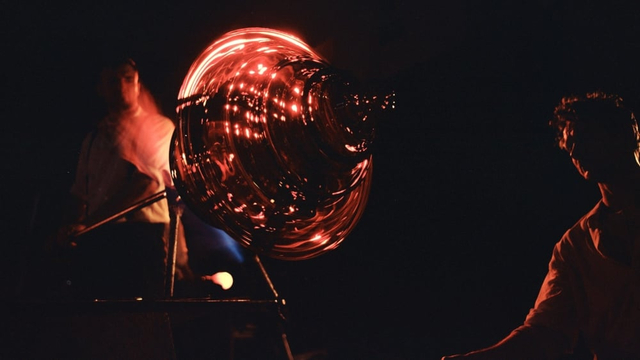
Inside the Making of Glass at Ajeto and Lasvit Fusing
Glass is as old as fire and as modern as tomorrow. In Northern Bohemia, the craft has burned for over a thousand years, carried forward today in two very different worlds: the fiery chaos of Ajeto’s hand-blown glass, and the quiet precision of Lasvit’s fusing kilns. Together they show how a material of paradoxes continues to surprise us.
Glass is a material of paradoxes. First it is liquid, then it is solid. It is strong yet fragile, heavy yet able to capture the lightest ray and let it shine through. Both ancient and modern, it embodies the transformation of earth, fire, air, and water, turning raw matter into something luminous. And for more than a thousand years, that transformation has been part of life in Northern Bohemia. In the hills and valleys of Crystal Valley, fire here has never gone out, carried from one generation to the next. These are the foundations Lasvit is built on, and here the spirit of glass is in good hands, supported by a deep appreciation for traditional methods and a commitment to cultivate them for the future. Quite symbolically, Lasvit’s headquarters stands in restored 18th-century timbered houses that once served as a glassmaking school – a reminder that education and continuity are as vital to the craft as fire itself. "Heat intuition and material sensitivity that can be acquired only by years of sweat and patience by the furnace." It was here in the Crystal Valley, where legendary designer Bořek Šípek, whose daring design defined an era, and his associates founded Ajeto in the early 1990s. Built on freedom, risk, and craftsmanship, Ajeto broke away from industrial repetition and became a place where artists, designers, and craftspeople could push the material to its limits. Artists such as Dale Chihuly and Marvin Lipofsky came here to test the limits of the material handled by some of the rarest skills in the field. The Tour de France trophy is brn here each year, alongside daring works that have entered cultural history. Today, Ajeto is part of Lasvit, which continues to promote and protect the unique skills of Bohemian glassmaking. Rather than merely adhering to established techniques, Lasvit views its artisans as true artists, and glass as their playground for experimentation. "Handmade objects radiate creative and humanistic energy that can be felt even in complete darkness." Lasvit’s workshops are home to some of the most skilled artisans, where nearly every glass technique is practiced under one roof: mould-making, glassblowing, hot sculpting, flame working, casting, fusing, cold working, etching, sandblasting, gilding, engraving, and assembling. Artisans of Lasvit's own glassshop is one of the few glassworks that still mixes its own colors. Its sixpot furnace offers unparalled flexibility melting multiple glass types and colors at once, from pure crystal to experimental batches like uranium glass. "I close my eyes and visualize the final piece in three dimensions before I begin, ensuring accuracy and artistic intent throughout the process." At Ajeto, glassmakers move between intricate details and monumental works. Their physical strength and endurance make the largest pieces possible, yet it is their attention to detail that renders each work precise, refined, and visually effortless. If Ajeto is all fire, sweat, and creative chaos, then Lasvit’s fusing facility feels like another world. The flames are hidden behind closed kilns, the atmosphere is calm, minimal, and precise. Instead of molten bubbles spun from a blowpipe, vast glass sheets are transformed into textured surfaces that carry both monumentality and refinement. Glass fusing is an ancient technique that has found a contemporary revival. It elevates a plain sheet of flat glass into an elaborate masterpiece. The process begins on a perfectly smoothed base surface that becomes a kind of canvas. Once the layer is prepared, textures are shaped using both traditional and unorthodox tools. “Usually we might use spoons, brushes, rollers adorned with motifs, or bubble wrap – and even our own hands,” explains Šárka Grubauerová, who has been working in Lasvit’s glassworks more than two years. When the surface is ready, the glass is placed into the world’s largest fusing kiln, a playground for textures and vertical applications. At high temperatures, the jumbo-sized glass melts, absorbing every imprint, every gesture, until the design is locked into its surface. This is where iconic projects come to life, from the dramatic Splash sculpture to the monumental glass walls of the new Fairmont Hotel in Prague. Each work carries the memory of the creative act that shaped it, whether it was a pressed handprint, the trace of a branch, or a scatter of crushed shards that now gleam like frozen stardust. “Every time the procedure unfolds, we gasp with anticipation as to the outcome,” says Šárka. “The Czech people have a particular penchant for playfulness,” she adds, a reminder that behind all the technical precision lies a spirit of discovery. It is a never-ending journey that transforms ordinary sheets of glass into something extraordinary, fused with a story only this material can tell. From molten breath to monumental sheets, glass carries the mark of human hands in every form. At Lasvit, those hands still guard the fire of the past while shaping surfaces that have never existed before. To stand before a finished piece – whether a fragile vessel blown in Ajeto or a wall of fused glass – is to see transformation made permanent. It is earth, fire, air, and water, but also endurance, playfulness, and imagination, fused into light. When Sand Goes to Heaven

Workers of the Fire that Has Been Burning for Millenia


Playground of Creation


World-largest fusing kiln



Guardians and Pioneers
